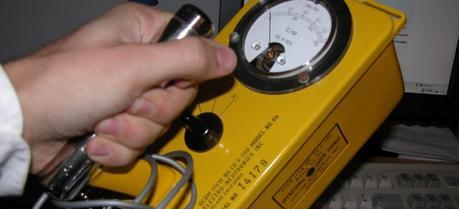 A Geiger-Müller counter. (Credit: Flickr @ Leonardo Rizzi https://www.flickr.com/photos/stars6/)
A Geiger-Müller counter. (Credit: Flickr @ Leonardo Rizzi https://www.flickr.com/photos/stars6/)A study finds that hydraulic fracturing can increase groundwater radioactivity, but not above exposure limits set for human health in the UK.
ReFINE (Researching Fracking in Europe), an independent research consortium focusing on the issue of shale gas and oil exploitation using fracking methods, has published a research paper on naturally occurring radioactive material (NORM) in flowback water.
SEE ALSO: Support for Fracking Declines in UK
The key findings are:
1. Flowback fluids from shale gas exploitation will contain increased concentrations of radioactive elements relative to local groundwaters.
2. Fluxes are within the range of those that might be experienced elsewhere in the world from use of natural groundwaters; lower than other discharges even from the non-nuclear sector; and lower than those from other energy production including both conventional offshore oil and gas production.
3. Fluxes in flowback fluids predicted for UK shale exploitation are not above exposure limits set for human health in the UK.
Published in Environmental Science & Pollution Research on 18th June 2014 (see footnote) following a peer review process, the research paper entitled “The flux of radionuclides in flowback fluid from shale gas exploitation” is authored by academics from Durham University (UK).
The research paper examined the changing levels of radioactivity in flowback fluid at three different geological locations: the Bowland shale (UK), the Silurian shale (Poland) and the Barnett shale (USA). In all three locations, the “worst case scenario,” whereby radioactivity levels in the flowback fluid were considered as values with only 1% chance of being exceeded, would not result in increased flowback fluid radioactivity to a level greater than the annual exposure limit set by the UK Environment Agency.
In a “worst case scenario” for the Barnett shale and Silurian shale, radioactivity of flowback fluid would be between seven and eight times the levels expected from local groundwater. For the Bowland shale, a “worst case scenario” found that flowback fluid would be 500 times more radioactive than the level expected from local groundwater. However, this would still be less than the Environment Agency’s annual exposure limit.
The research paper highlighted that some radioactivity in the environment occurs naturally. For example, radon (Rn) is commonly found in groundwater. In the Carrick District of Cornwall (UK), average radon levels from 17,000 houses were almost seven times greater than the average level across England.
The paper also examined the volumes of water and “worst case scenario” radioactivity of water used in comparable industries such as the offshore oil and gas industry and nuclear industry. It found that radioactivity release in water would be higher for both offshore oil and gas and nuclear power generation, than those estimated for shale gas operations.
If water discharged from North Sea oil and gas installations was rescaled to the volumes expected for use in the Bowland shale, changes in water radioactivity levels would be three times greater than predictions made for shale gas operations. Similarly, if an equivalent volume of waste water was pumped from a nuclear power plant, radioactive contamination would be two orders of magnitude larger than estimated radioactivity for pumped flowback fluid from shale gas developments.
Within the regulatory framework for environmental protection in the UK, flowback fluids from shale gas exploration or exploitation would not be allowed to discharge untreated into surface or ground waters.
Professor Fred Worrall, a Professor of Environmental Chemistry at Durham University and author of the paper, said:
“The findings of this research confirm that levels of water radioactivity in the flowback water from shale gas operations would be lower than the annual exposure limit set by the Environment Agency and would not pose a significant threat to public health.
“It is important to bear in mind the context of the shale gas industry against other forms of energy production. We, in the UK, already handle larger volumes of fluid with higher radioactivity from other energy industries, such as conventional oil and gas production.”
Professor Richard Davies, of Durham University and ReFINE Project Leader, commented:
“The publication of ReFINE’s fourth research paper comes at a critical time in the national debate around shale gas and oil exploitation. It underlines the need to have up-to-date independent and impartial scientific research on issues which the public wants and the government needs. As the findings of our latest paper make clear, we must remember to set fracking in the context of other types of energy.”
Almond, S., Clancy, S., Davies, R., & Worrall, F. (2014). The flux of radionuclides in flowback fluid from shale gas exploitation Environmental Science and Pollution Research DOI: 10.1007/s11356-014-3118-y
